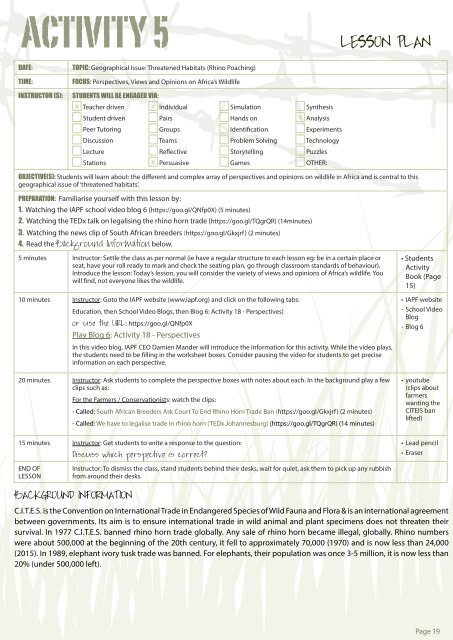You also want an ePaper? Increase the reach of your titles
YUMPU automatically turns print PDFs into web optimized ePapers that Google loves.
ACTIVITY 5<br />
LESSON PLAN<br />
DATE:<br />
TIME:<br />
TOPIC: Geographical Issue: Threatened Habitats (Rhino Poaching)<br />
FOCUS: Perspectives, Views and Opinions on Africa’s Wildlife<br />
INSTRUCTOR (S):<br />
STUDENTS WILL BE ENGAGED VIA:<br />
x <strong>Teacher</strong> driven<br />
Student driven<br />
x Individual<br />
Pairs<br />
Simulation<br />
Hands on<br />
Synthesis<br />
x Analysis<br />
Peer Tutoring<br />
Groups<br />
Identification<br />
Experiments<br />
Discussion<br />
Teams<br />
Problem Solving<br />
Technology<br />
Lecture<br />
Stations<br />
Reflective<br />
x Persuasive<br />
Storytelling<br />
Games<br />
Puzzles<br />
OTHER:<br />
OBJECTIVE(S): Students will learn about: the different and complex array of perspectives and opinions on wildlife in Africa and is central to this<br />
geographical issue of ‘threatened habitats’.<br />
PREPARATION: Familiarise yourself with this lesson by:<br />
1. Watching the IAPF school video blog 6 (https://goo.gl/QNfp0X) (5 minutes)<br />
2. Watching the TEDx talk on legalising the rhino horn trade (https://goo.gl/TQgrQR) (14minutes)<br />
3. Watching the news clip of South African breeders (https://goo.gl/Gkxjrf) (2 minutes)<br />
4. Read the Background Information below.<br />
5 minutes Instructor: Settle the class as per normal (ie have a regular structure to each lesson eg: be in a certain place or<br />
seat, have your roll ready to mark and check the seating plan, go through classroom standards of behaviour).<br />
Introduce the lesson: Today’s lesson, you will consider the variety of views and opinions of Africa’s wildlife. You<br />
will find, not everyone likes the wildlife.<br />
10 minutes Instructor: Goto the IAPF website (www.iapf.org) and click on the following tabs:<br />
Education, then School Video Blogs, then Blog 6: Activity 18 - Perspectives)<br />
or use the URL: https://goo.gl/QNfp0X<br />
Play Blog 6: Activity 18 - Perspectives<br />
In this video blog, IAPF CEO Damien Mander will introduce the information for this activity. While the video plays,<br />
the students need to be filling in the worksheet boxes. Consider pausing the video for students to get precise<br />
information on each perspective.<br />
20 minutes Instructor: Ask students to complete the perspective boxes with notes about each. In the background play a few<br />
clips such as:<br />
For the Farmers / Conservationists: watch the clips:<br />
- Called: South African Breeders Ask Court To End Rhino Horn Trade Ban (https://goo.gl/Gkxjrf) (2 minutes)<br />
- Called: We have to legalise trade in rhino horn (TEDx Johannesburg) (https://goo.gl/TQgrQR) (14 minutes)<br />
15 minutes Instructor: Get students to write a response to the question:<br />
Discuss which perspective is correct?<br />
• Students<br />
Activity<br />
<strong>Book</strong> (Page<br />
15)<br />
• IAPF website<br />
- School Video<br />
Blog<br />
- Blog 6<br />
• youtube<br />
(clips about<br />
farmers<br />
wanting the<br />
CITEIS ban<br />
lifted)<br />
• Lead pencil<br />
• Eraser<br />
END OF<br />
LESSON<br />
Instructor: To dismiss the class, stand students behind their desks, wait for quiet, ask them to pick up any rubbish<br />
from around their desks.<br />
BACKGROUND INFORMATION<br />
C.I.T.E.S. is the Convention on International Trade in Endangered Species of Wild Fauna and Flora & is an international agreement<br />
between governments. Its aim is to ensure international trade in wild animal and plant specimens does not threaten their<br />
survival. In 1977 C.I.T.E.S. banned rhino horn trade globally. Any sale of rhino horn became illegal, globally. Rhino numbers<br />
were about 500,000 at the beginning of the 20th century, it fell to approximately 70,000 (1970) and is now less than 24,000<br />
(<strong>2015</strong>). In 1989, elephant ivory tusk trade was banned. For elephants, their population was once 3-5 million, it is now less than<br />
20% (under 500,000 left).<br />
Page 19



